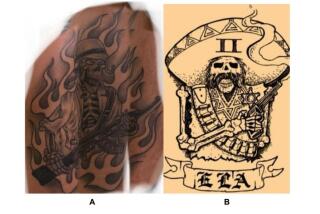Tattoo in sheriff’s deputy clique may have celebrated shootings, sources say
- Share via
The investigation into a secret clique within the Los Angeles County sheriff’s elite gang unit has uncovered allegations that members had matching tattoos of a gun-toting skeleton, which deputies would modify to celebrate their involvement in a shooting, according to sources close to the internal probe.
One deputy, who has admitted belonging to a clique called the “Jump Out Boys,” has identified about half a dozen other deputies as members, one source confirmed. Those men are expected to be summoned for interviews with internal affairs investigators, the source said.
Suspicion about the group’s existence was sparked several weeks ago when a supervisor discovered a pamphlet laying out the group’s creed, which promoted aggressive policing and portrayed officer shootings in a positive light.
The pamphlet was found in the vehicle used by the deputy who acknowledged his association with the clique, according to sources who requested anonymity because they were not authorized to speak about the ongoing investigation.
Days after The Times reported on the discovery of the pamphlet, the captain of the division gathered his deputies for a private briefing, during which he told them they had shamed the department by forming the group and urged those responsible to identify themselves, a source with knowledge of the unit’s inner workings said.
At some point, one deputy came forward, and he has since named about six others, the source said.
Internal affairs investigators are trying to determine whether the deputies violated Sheriff’s Department rules or committed serious misconduct.
The deputies under scrutiny all work on the Gang Enforcement Team, a unit divided into two platoons of relatively autonomous deputies whose job is to target neighborhoods where gang violence is high, locate armed gang members and take their guns away.
The design of the tattoo, confirmed by two sources, includes an oversize skull with a wide, toothy grimace and glowing red eyes. A bandanna wraps around the skull, imprinted with the letters “OSS” — representing Operation Safe Streets, the name of the larger unit that the Gang Enforcement Team is part of. A bony hand clasps a revolver. Investigators suspect that smoke is tattooed over the gun’s barrel after a member is involved in a shooting.
To the left of the skull are two playing cards — an ace and an eight — apparently an allusion to the “dead man’s” poker hand, sources said.
One source compared the notion of modifying the tattoo after a shooting to a celebratory “high five.”
Celebrating shootings and sporting matching tattoos were hallmarks of anti-gang officers in the LAPD’s troubled Rampart Division in the late 1990s.
A corruption scandal erupted after one disgraced officer implicated himself and others in covering up bad shootings, planting evidence, falsifying reports and perjuring themselves to rid the streets of gang members and drug dealers.
In fact, the tattoo allegedly embraced by the Jump Out Boys is reminiscent of the one inked on Rampart officers, which consisted of a grinning skull in a cowboy hat with pairs of aces and eights fanned out in the background.
Sources say there is no evidence that deputies alleged to be in the clique have been involved in improper shootings or other misconduct. But the new revelations have heightened concerns.
The modified tattoos could also pose problems for the department in future litigation, making it more difficult for county attorneys to argue against lawsuits alleging bad shootings.
Sheriff Lee Baca’s spokesman, Steve Whitmore, declined to discuss details of the investigation because it is ongoing. “We take this very seriously,” he said. “This is absolutely no joke whatsoever.”
The department has been grappling with unsanctioned cliques in its ranks for decades.
Last year, the department fired a group of deputies who all worked on the third, or “3000,” floor of Men’s Central Jail after the group fought two fellow deputies at an employee Christmas party and allegedly punched a female deputy in the face.
Sheriff’s officials later said the men had formed an aggressive “3000” clique that used gang-like three-finger hand signs. A former top jail commander told The Times that jailers would “earn their ink” by breaking inmates’ bones.
The Jump Out Boys, sources said, was a name coined by Compton-area gang members alluding to how quickly deputies from the unit would jump out of patrol vehicles to stop them.
Other cliques — with names like Grim Reapers, Little Devils, Regulators and Vikings — have been accused of breeding a gang-like mentality in which deputies falsify police reports, perjure themselves and cover up misconduct. Past affiliation with such groups reaches the highest levels of the department.
Baca acknowledged last year that his second-in-command, Paul Tanaka, has a Vikings tattoo. Tanaka has said the Vikings was a nickname for deputies assigned to the Lynwood station and did not represent anything sinister.
Some argue that the groups are not inherently problematic, providing cops working a dangerous job with camaraderie and emotional support. Experts say cliques become a problem when they push officers to put their comrades ahead of the law and department policy.
What investigators are most concerned about with the Jump Out Boys isn’t the alleged matching tattoos, but the suspected admiration they show for shootings. Officer-involved shootings are expected to be events of last resort.
Maria Haberfeld, a professor at John Jay College of Criminal Justice in New York who specializes in police ethics and training, said joining police subcultures makes officers “vulnerable to be compromised by group think and group pressure.” Tattoos that further distinguish officers involved in shootings, she said, are particularly problematic.
“Even though they are authorized to use deadly force, I don’t think it’s a cause for celebration,” she said. “When you reach a point in your career that you have no choice but to use deadly force, if anything it’s incredibly traumatic for the shooter. It’s a little bizarre to commemorate a tragic event.”
More to Read
Sign up for Essential California
The most important California stories and recommendations in your inbox every morning.
You may occasionally receive promotional content from the Los Angeles Times.











